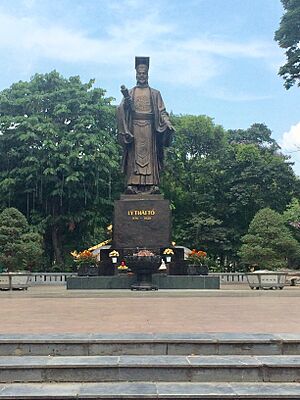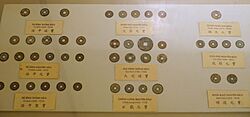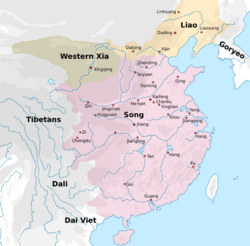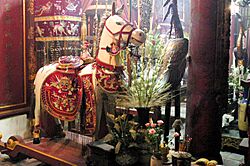Lý Thái Tổ facts for kids
Quick facts for kids Lý Thái Tổ李太祖 |
|||||||||||||||||||||
|---|---|---|---|---|---|---|---|---|---|---|---|---|---|---|---|---|---|---|---|---|---|
| Great Emperor of Đại Cồ Việt | |||||||||||||||||||||
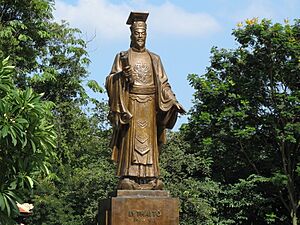
Statue of Lý Thái Tổ beside the Hoàn Kiếm Lake in Hanoi
|
|||||||||||||||||||||
| Emperor of Đại Cồ Việt | |||||||||||||||||||||
| Reign | 1009–1028 | ||||||||||||||||||||
| Predecessor | Lê Long Đĩnh | ||||||||||||||||||||
| Successor | Lý Thái Tông | ||||||||||||||||||||
| Emperor of the Lý dynasty | |||||||||||||||||||||
| Reign | 20 November 1009–31 March 1028 | ||||||||||||||||||||
| Predecessor | Dynasty established | ||||||||||||||||||||
| Successor | Lý Thái Tông | ||||||||||||||||||||
| Born | 8 March, 974 Cổ Pháp, Bắc Ninh, Đại Cồ Việt |
||||||||||||||||||||
| Died | 31 March 1028 (aged 54) Thăng Long, Đại Cồ Việt |
||||||||||||||||||||
| Burial | Thọ Tomb | ||||||||||||||||||||
| Spouse | Lê Thị Phật Ngân and 8 other empresses | ||||||||||||||||||||
| Issue | Prince of Khai Thiên Lý Phật Mã as emperor Lý Thái Tông Prince of Khai Quốc Lý Bồ Prince of Đông Chinh Lý Lực Prince of Vũ Đức (?–1028) Prince of Uy Minh Lý Nhật Quang Princess An Quốc 8 sons, and 13 daughters. |
||||||||||||||||||||
|
|||||||||||||||||||||
| House | Lý | ||||||||||||||||||||
| Father | Hiển Khánh vương | ||||||||||||||||||||
| Mother | Minh Đức Thái hậu Phạm Thị | ||||||||||||||||||||
| Religion | Buddhism | ||||||||||||||||||||
| Temple name | |
| Vietnamese alphabet | Lý Thái Tổ |
|---|---|
| Chữ Hán | 李太祖 |
| Personal name | |
| Vietnamese alphabet | Lý Công Uẩn |
|---|---|
| Chữ Hán | 李公蘊 |
Lý Thái Tổ (chữ Hán: 李太祖, born March 8, 974 – died March 31, 1028), whose personal name was Lý Công Uẩn, was a very important emperor in Vietnamese history. He founded the Lý dynasty and was the 6th ruler of Đại Việt. He ruled from 1009 to 1028.
Contents
Early Life and Rise to Power
Lý Công Uẩn was born in 974 in Cổ Pháp village, which is in today's Bắc Ninh Province. We don't know much about his birth parents. When he was three, he was adopted by a man named Lý Khánh Vân.
Lý Công Uẩn was taught by Vạn Hạnh, a famous Buddhist leader of that time. He became known for being a very religious Buddhist. He also studied history and became a soldier. Slowly, he moved up from a small job to a very important position in the royal guards. This job was called The Commander of the Palace's Left Flank.
In 1005, the emperor Lê Hoàn died. This led to a struggle for power among his sons. Lý Công Uẩn started working in the royal court. He became a trusted helper to the person who was supposed to become the next emperor.
By 1009, the emperor Lê Long Đĩnh was very sick. He was the last emperor of the Lê family. People were not happy with him because he was not a good ruler. A royal official named Đào Cam Mộc and the Buddhist leader Vạn Hạnh saw this as a chance. They helped Lý Công Uẩn become the new emperor. This marked the end of the Lê dynasty.
Just two days after Lê Long Đĩnh died, Lý Công Uẩn was declared emperor. He had the support of monk Vạn Hạnh and many other Buddhist leaders. After becoming emperor, Lý Công Uẩn named his reign "Thuận Thiên," which means "Accordance with Heaven's Will."
His Reign as Emperor
Moving the Capital City
In 1010, the emperor decided to move the capital city. The old capital was in Hoa Lư. The new capital would be at a place called Đại La, which is modern-day Hanoi. Đại La was a city built a long time ago by a Chinese general.
Lý Công Uẩn explained why he chose Đại La. He said it was a great place, "between Heaven and Earth where the coiling dragon and the crouching tiger lie." He believed his capital would last for 10,000 years there. When his boat arrived at the new capital, people said a dragon flew above his head. Because of this, he renamed the city Thăng Long, which means "ascending dragon."
The new royal city in Thăng Long was built in a special way. It had a Royal City in the middle. The main palace where the king met people was called Càn Nguyên Palace. By 1010, 11 palaces were built in Thăng Long. You can still see parts of the old city walls near modern Hanoi.
Changes at Home
Lý Thái Tổ made changes to how the country was run. He changed the way the land was divided. Instead of "ten circuits," he created 24 "routes." These routes helped organize different areas. He also set up military outposts in the southern parts of the country.
Officials in different areas didn't get a salary from the capital. They used local resources like fish and rice. Soldiers also got some support and were expected to do some farming. Villages mostly managed themselves. They would send some resources to their local leader, who would then send a share to the emperor. This system was like a "mandala" system, common in Southeast Asia.
In 1011, Lý Thái Tổ led a large army to deal with rebels in the southern provinces. He spent two years there, burning villages and capturing local leaders. In 1012, while returning by sea, a big storm hit his boat. He felt this was a sign that he had been too harsh.
From 1013 to 1015, Lý Thái Tổ sent soldiers to the northern mountains. They worked to bring peace to the Hani people who were allied with the Dali Kingdom.
He also improved the tax system in 1013. He created six different tax groups. This made it easier for the government to collect taxes and for people to understand what they needed to pay. Taxes were on things like:
- Fishing and seafood
- Farming
- Wood and stone
- Salt
- Luxury items (like ivory and gold)
- Fruits and vegetables
When a big earthquake happened in 1016, Lý Thái Tổ prayed to the gods of the mountains. He also sent over 1,000 people to teach in Buddhist schools. He traveled around his kingdom to honor local spirits and traditions.
Dealing with Other Countries
During Lý Thái Tổ's rule, the Song dynasty in China was busy with its own problems. Because of this, Đại Việt was mostly left alone. The relationship between the two countries became friendly again. In 1010, the Song emperor quickly recognized Lý Công Uẩn as the ruler of Đại Việt.
In 1010, Lý Thái Tổ captured some bandits and sent them to the Chinese court. In 1014, he sent a group to China with 60 horses as gifts. He also told the Song court that he had brought peace to a Hani community.
Religious Beliefs and Actions
Lý Thái Tổ had been a Buddhist monk before becoming emperor. He continued to practice Buddhism and made it the national religion. He gave a lot of support to Buddhist monks and temples. He donated money to build pagodas (Buddhist temples) all over Đại Việt. He built 8 temples in the Tiên Du area and three more near the capital.
He also brought important local spirits and traditions to the capital. For example, the spirits of the Trưng sisters and other local gods were moved to temples in Thăng Long. This helped show that the emperor's power reached all parts of Đại Việt.
In 1024, a temple was built for Lý Thái Tổ to read and recite Buddhist scriptures. He had received a copy of these scriptures from the Song court a few years earlier. He showed great interest in connecting with spiritual powers. He supported Buddhism and local traditions, which helped strengthen his rule.
In 1025, Vạn Hạnh, his teacher and mentor, passed away. Vạn Hạnh had been a key person in helping Lý Thái Tổ become emperor. After Vạn Hạnh's death, not much more is recorded about Lý Thái Tổ until he died.
Death
Lý Công Uẩn died in 1028 when he was 55 years old. He was buried at Thọ Lăng, which means "Mausoleum of Longevity." After his death, he was given the special name "Lý Thái Tổ." His imperial title was "Thần Võ Hoàng Đế." Today, people still honor Lý Thái Tổ's spirit in national shrines.
Legacy
The Lý Thái Tổ, a modern warship in the Vietnam People's Navy, is named after him.
Family
- Father
- Hiển Khánh vương (honored by Lý Thái Tổ in 1010)
- Lý Khánh Vân (adoptive father)
- Brothers
- Dực Thánh Vương
- Lý Mỗ
- Wives
- Empress Lập Giáo
- Lady Chu Ái Vân
- Children
- Lý Phật Mã
- Lý Long Bồ (?–1069)
- Lý Lực
- Lý Cập
- Lý Phó
- Lý Nhật Quang (995–1057)
- Princess An Quốc
- Princess Lĩnh Nam (Lý Thị Bảo Hòa)


